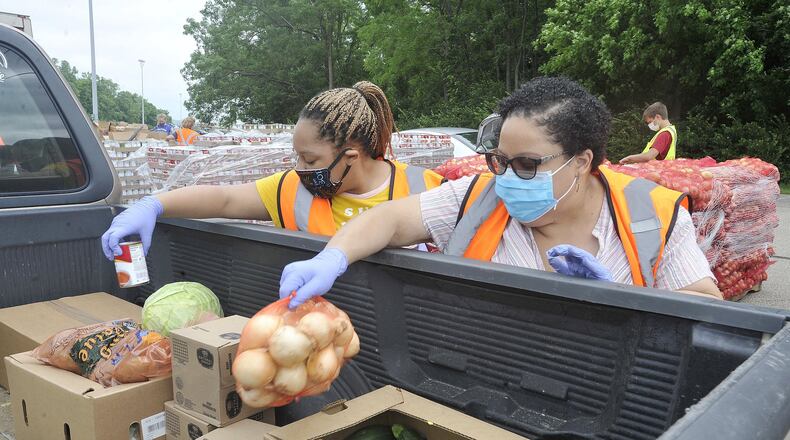“I am so grateful to be able to have this,” Henry said. “It’s good to know there are programs like this out there. This food will really help, especially with the kids being home right now.”
Henry said she had never used the Foodbank before, but had used a food pantry near her home in Xenia in the past.
The need for food by people in the Dayton area increased sharply in March and the first part of April, according to service data from the Foodbank.
The Foodbank served twice as many households in March than it did in February at their drive-thru food pantry. About 2,000 families were served in February. That number jumped to 4,684 in March, said said Chief Development Officer Lee Lauren Truesdale. More than 8,000 were served in April, but that included two mass food distributions.
During a mass food distribution at the Nutter Center in April, the Foodbank served 1,400 households, making it the largest food distribution in its history.
The Foodbank served 2,110 people on Wednesday, or 667 households. More than 500 of those 667 households were new to the food assistance system, Truesdale said.
Many of the Foodbank’s partner agencies, like local food pantries, closed during March, April and May, causing more people to go to the drive-thru, Truesdale said. Most of those local pantries will be reopened by the end of this month.
Henry said getting fresh produce was a huge win for her family because produce is often picked-over or in low stock at the grocery store. Henry said she has been working for Instacart and Doordash to make some extra money, which has been extremely busy during the pandemic.
“There are just so many unknowns right now,” Henry said. “It’s been helpful to get the stimulus check and they increased our food stamps, but Ohio’s unemployment system is a mess right now. It took my husband nearly the whole time he was laid off to get everything worked out, but then he got called back to work.”
RELATED: Foodbank to hold mass distribution at Nutter Center on Wednesday
About 300 families came through in the first hour, Truesdale said.
Roberta White and Marvel Johnson are both out of work right now and got food from the mass distribution. White said she worked security for various events, and with large gatherings and events canceled because of the coronavirus, she has been laid off.
“If I didn’t have Social Security, I would be broke,” White said.
The need for food assistance has remained steady since the state began opening back up, Truesdale said.
“A lot of folks, their lives have stabilized,” Truesdale said, “but that’s not the whole picture.”
Katie Bruggeman, who just graduated from Wright State with a mechanical engineering degree, said she has to save everything now because the coronavirus has made her job hunt uncertain.
Getting food from the Foodbank allows her to save money on groceries. Bruggeman was at the Nutter Center on Wednesday getting food for herself and two others. She had never been to a food bank or food pantry before.
“I’m definitely putting job applications out there, but the interview process has pretty much halted,” Bruggeman said.
Bruggeman said she has been using Wright State’s Career Services and LinkedIn to try to find a job.
The Foodbank predicts that there could be an increased need for food assistance into next year.
About the Author

